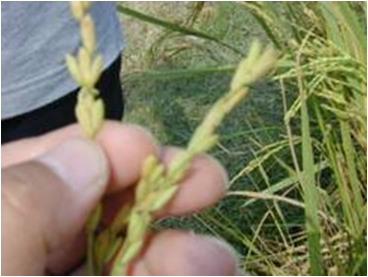What it is to have friends, especially knowledgeable friends. Bhuwon Sthapit, local rice wallah extraordinaire, 1 responded quickly and in depth when asked what he knew about triple-grained rice.

Unique local rice landraces in Nepal are being lost, replaced by modern varieties. At least two of these are multi-seeded: Laila Majnu (the name refers to a pair of famous lovers, never separated until death) and Amaghauj (which means cluster of mango). Until 1999 Amaghauj was grown by one farmer on 3 katha of land, but was discontinued as the land was sold to another farmer. This local variety has a cluster of spikelets (at least 3 potential grains) originating from the same base; this heritable trait could potentially be used to breed new rice types offering increased yield. It is currently saved in community seed banks.
As Bhuwon also notes:
There is great potential to link community seed bank and national seed bank to harness such untapped and unknown resources.
And if you want even more, another friend, Ruaraidh Sackville Hamilton, Head of the IRRI genebank, points to Morphological Observations on Many Kerneled Grains in Rice. Don’t be scared by the Chinese; English follows.
LATER: For completeness, the name of the Bangladeshi variety which started all this, Biram Sundori, means “beautiful girl from Birampur,” which is the place where it is grown. Thanks to Zakir Sor for leading us all on this journey of discovery.
Glad to read such innovative issues. But the latest data in Nepal says there is 88% coverage by modern rice varieties. Farmers must get the incentives or economic return from the landraces then only they will be after the heirloom varieties otherwise the traditional varieties will go on disappearing year after year. The gene bank in IRRI and Norway (Svalbard) must be congratulated for the conservation and use of heirloom rice varietites.
Is not just to farm rice! It also how to processed it and riserve then uses it world wide!